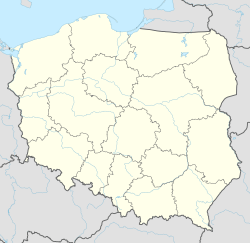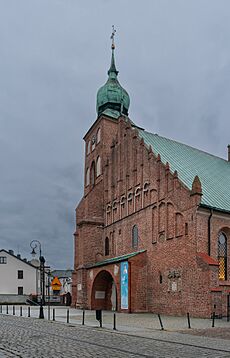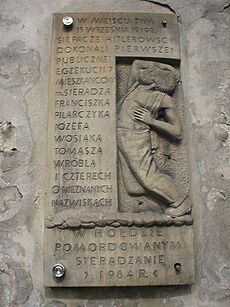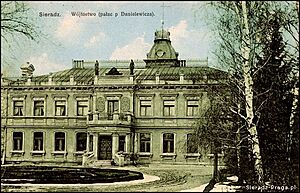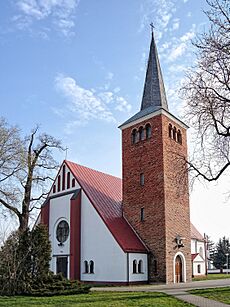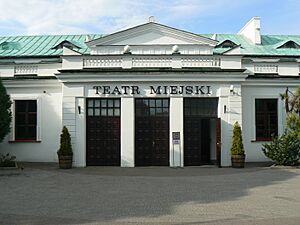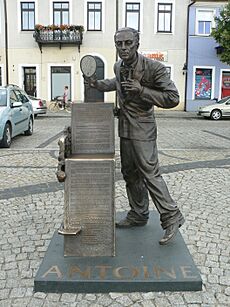Sieradz facts for kids
Quick facts for kids
Sieradz
|
|||
|---|---|---|---|
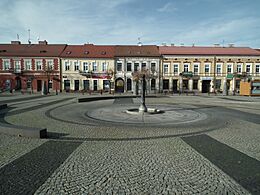
Market Square
|
|||
|
|||
| Country | |||
| Voivodeship | |||
| County | Sieradz | ||
| Gmina | Sieradz (urban gmina) | ||
| Established | 11th century | ||
| First mentioned | 1136 | ||
| City rights | 1247 | ||
| Area | |||
| • Total | 51.22 km2 (19.78 sq mi) | ||
| Population
(31 December 2021)
|
|||
| • Total | 40,891 |
||
| Time zone | UTC+1 (CET) | ||
| • Summer (DST) | UTC+2 (CEST) | ||
| Postal code |
98-200
|
||
| Area code(s) | +48 043 | ||
| Car plates | ESI | ||
| Highways | |||
| National roads | |||
Sieradz is a city in central Poland. It is located on the Warta river. In 2021, about 40,891 people lived there. Sieradz is the main city of the Sieradz County in the Łódź Voivodeship. It is also the historical capital of the Sieradz Land region.
Sieradz is one of the oldest cities in Poland. It was a very important city during the Middle Ages. Polish kings were chosen here three times! They also held important meetings in Sieradz six times. Historically, Sieradz was the capital of different important areas. These included the Duchy of Sieradz and the Sieradz Voivodeship.
Contents
History of Sieradz
Early Beginnings and Growth
People first settled in the Sieradz area around the 6th century. The city was first mentioned in a document from 1136. In the mid-1200s, Duke Casimir I of Kuyavia gave Sieradz its city rights. Many people from Scotland and the Netherlands moved to Sieradz after the 13th century.
During a time when Poland was divided, Sieradz became the capital of the Duchy of Sieradz in 1263. Later, in 1339, this duchy became the Sieradz Voivodeship (1339–1793). Polish King Casimir III the Great even built a castle in Sieradz. In the Middle Ages, the town faced attacks from the Mongols, Bohemians, and Teutonic Knights.
Sieradz was a significant royal town for Poland's kings. In 1445, King Casimir IV Jagiellon was chosen in Sieradz. Until the 16th century, the city was a busy trading center. Merchants from Spain and Portugal often came to trade here. In the 17th century, the city lost its importance. This was due to Swedish invasions, diseases, fires, and floods. By the 18th century, only about 1,500 people lived there. The city then began to rebuild.
Changes and Partitions
In 1793, Sieradz was taken over by Prussia during the Second Partition of Poland. But on November 13, 1806, Polish people in Sieradz started an uprising against the Prussians. In 1807, Sieradz became part of the Duchy of Warsaw, a short-lived Polish state. After this duchy ended in 1815, Sieradz became part of Congress Poland. This area was controlled by the Russian Empire. Sieradz was the capital of a district within the Kalisz Governorate.
During the January Uprising in 1863, Polish fighters attacked Russian soldiers in the town. More fights happened in 1864. After World War I ended in 1918, Poland became independent again. Sieradz returned to Polish control.
Sieradz During World War II
In 1939, Nazi Germany and the Soviet Union invaded Poland, starting Second World War. Sieradz was attacked on September 9 and taken over by the German army. Germany then took control of Sieradz, renaming it Schieratz. Before the war, about 40% of the people in Sieradz were Jewish. Today, Sieradz remembers its Jewish history with a special day each January.
In September 1939, the Germans used the local prison as a temporary camp for Polish soldiers. Almost 3,000 soldiers were held there, even though the prison was built for only 1,100. During the German occupation, many terrible things happened to the people of Sieradz. On September 15, 1939, the Germans publicly executed seven Poles. In November 1939, they arrested 62 important local people. On November 14, they forced local Jews to dig graves and then killed 20 of these hostages. The victims included teachers, police officers, and the pre-war mayor. In late 1939, 522 Polish families were forced to leave their homes.
The Germans tried to make Sieradz more German. They destroyed Polish historical records, monuments, and buildings. Street names were changed to remove any Polish identity.
The local prison became a very important German prison. Prisoners, mostly Poles and Jews, were treated badly. They were insulted, beaten, and forced to work. Many died from hunger or torture. After the war, a historian found that at least 968 people died or were killed in this prison. Despite these dangers, the Polish resistance movement worked secretly in the area. The last prisoner executed was Antonina Chrystkowa, a woman from the resistance, on January 18, 1945.
Soviet planes bombed Sieradz, killing over 100 residents. After three days of fighting, the Red Army arrived on January 23, 1945. The day before the Germans left, the historic Danielewicz Palace was burned down. Sieradz was returned to Poland, but a Soviet-backed government was put in place. This government stayed until the 1980s.
Sieradz in Recent Times
In 1947, young Polish people in Sieradz started a secret group. They were against the communist government. This group later called itself Katyń. They wanted to remember the Katyn massacre, where Soviets killed many Poles in 1940. The group collected weapons and shared secret information. They also printed and gave out independent Polish newspapers. The group's leader was Zbigniew Tur. He had been forced to work by both Germans and Soviets during the war. The communist government eventually stopped the group. Its members were sent to prison in 1951. However, people in the town showed their support for the arrested youth.
After the war, Sieradz developed its economy. It had clothing factories, cereal mills, and distilleries. From 1975 to 1998, Sieradz was the capital of the Sieradz Voivodeship.
Historical Leaders of Sieradz
Dukes of Sieradz-Łęczyca
- 1228-1232 Henry I the Bearded
- 1232-1233 Konrad of Masovia
- 1234-1247 Konrad of Masovia
- 1247-1261 Casimir I of Kuyavia
- 1261-1275 Leszek the Black
- 1275-1294 (Area divided into two smaller duchies)
- 1294-1297 Ladislaus III the Short
- 1297-1305 Wenceslaus II of Bohemia
After 1305, these areas became part of the united Kingdom of Poland (1138–1320).
Dukes of Sieradz
- 1233-1234 Bolesław I of Masovia
- 1275-1288 Leszek the Black
- 1288-1294 Ladislaus III the Short
- 1327-1339 Przemysł of Inowrocław
After 1339, King Casimir III the Great made Sieradz part of the Sieradz Voivodeship (1339–1793) within the Kingdom of Poland.
Politics in Sieradz
Members of Parliament from Sieradz
People elected to represent Sieradz in the Polish Parliament (Sejm) include:
- Joanna Lichocka
- Marcin Przydacz
- Paweł Rychlik
- Piotr Polak
- Tadeusz Woźniak
- Marek Mauszewski
- Cezary Tomczyk
- Agnieszka Hanajczyk
- Krzysztof Habura
- Paweł Bejda
- Jolanta Zięba-Gzik
- Paulina Matysiak
Current President of Sieradz
- Paweł Osiewała is the current mayor, also called the President, of Sieradz.
Sports, Fun, and Development in Sieradz
Sports and Recreation
Sieradz has a great Sports Town Centre. It has three football pitches, a running track, and two other sports grounds. There's also a hotel, restaurant, tennis courts, a sauna, and a health club. You can also find a swimming pool and a safe swimming area by the river. The local football team is Warta Sieradz. They play in the lower leagues.
The natural forests along the Warta river are perfect for picking mushrooms. The Rynek, which is the town square, has many historic buildings. It's a great place for tourists to visit. Local shops sell many good quality products. The churches in Sieradz are very old and have been beautifully restored.
City Development and Events
Sieradz has grown a lot since 2007. Many new homes and neighborhoods have been built. The city also has modern shopping malls like Galeria Sieradzka, Dekada, and Rondo. There are also several open-air markets. People from nearby villages and towns come to Sieradz to shop, making it a popular shopping spot. The city government hosts the Open Hair Festival every year. This event is very famous and makes Sieradz well-known.
Famous People from Sieradz
- Leszek II the Black (around 1240–1288), a powerful Duke of Poland.
- Jan Gruszczyński, an important church leader in medieval Poland.
- Cyprian Bazylik (around 1535–around 1600), a musician, writer, and printer.
- Ary Szternfeld (1905–1980), a scientist who studied space travel.
- Antoni ”Antoine” Cierplikowski (1884–1976), a famous hairdresser for celebrities.
- Arek Hersh, a survivor of the Holocaust and an educator.
- Zalman Ben-Ya'akov (1897–1959), an Israeli politician.
- Hymie Weiss, an American gangster.
- Hersh Leyb Zhitnitski (1891–1942), a Yiddish writer.
- Dina Shayevitsh (1891–1942?), a Yiddish actor.
Sister Cities
Sieradz has special partnerships with these cities:
Images for kids
See also
- Dukes of Sieradz-Łęczyca



